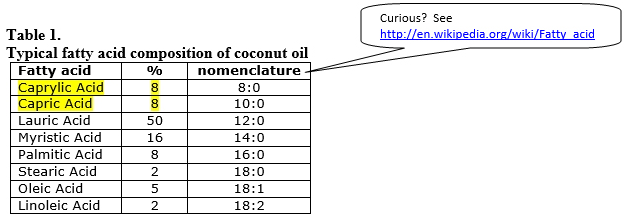As we sell natural organic coconut oil I would like to clarify some of the misconceptions surrounding ‘fractionated coconut oil’ (FCO). While it might sound like it is simply some naturally occurring fraction of coconut oil it is much more complicated than that. Firstly it is quite a process to make it. Through various industrial processes coconut oil is chemically broken down into its constituent fatty acids and glycerol.

These fatty acids are then separated from each other by fractional distillation and used commercially. For example, the lauric acid (which makes up about 50% of the total coconut oil fatty acids) can be used to make the synthetic detergents sodium lauryl sulphate and sodium laureth sulfate.
But what are they going to do with the remaining fatty acids, and the glycerine? One answer is to react them back together (esterification) to make synthetic triglycerides (manufactured oils). By reacting the caprylic and capric fatty acids with glycerine we get what is known as fractionated coconut oil (FCO). ‘Fractionated’ because it was made through a process of chemically breaking up (fractionating) the coconut oil and then fractionally vacuum distilling the fatty acids to separate them, before recombining them into FCO. It is also called caprylic/capric triglyceride, which is its chemical description. It can also be called a medium-chain triglyceride (MCT), because the caprylic and capric fatty acids that constitute the triglyceride are both of medium length (8 and 10 carbons long, respectively).
Caprylic and capric fatty acids are saturated (no double bonds in their carbon chain), so FCO is a fully saturated oil. This makes it very stable and resistant to oxidation and rancidity, giving it a very long shelf life. The fairly short medium-chain fatty acids make it a light non-greasy oil that readily absorbs into the skin. In part due to the shortness of the fatty acids chains and the good skin penetration some people may find it is a skin irritant.
So is FCO natural? No, not in the sense that it is made by a complex industrial process that chemically breaks coconut oil down and then reconstitutes some of the fatty acids into a new manufactured triglyceride (oil).
Neither does FCO (caprylic/capric trigyceride) make up any substantive proportion of the original natural coconut oil. Caprylic and capric fatty acids make up about 16% of the total fatty acids in coconut oil (Table 1) so you might think that there would be a fairly high percentage of caprylic/capric triglycerides in coconut oil. But there isn’t.
The probability that the three fatty acids linking onto the glycerol molecule are all either caprylic or capric fatty acids is very low. In fact caprylic/capric triglycerides make up far less than 1% of natural coconut oil. This low percentage explains why we don’t just extract caprylic/capric triglycerides straight from coconut oil. That is, you can't get FCO through fractional crystallization by slowly cooling coconut oil (though there are websites that try to explain it this way). FCO is a synthesized product.
Essentially it is an industrial spin-off from the manufacture of synthetic detergents. After you have used the lauric fatty acid, and the higher fatty acids (myristic, palmitic and stearic), to make lauryl sulphate, laureth sulphate and coco sulphate synthetic detergents you can then use the remaining caprylic and capric acids to make FCO.
Given the above information you can appreciate that it is misleading to describe FCO as simply a “highly purified oil”, or as having “the impurities removed” or as being “all-natural”. Though these are all terms on the internet used to promote it. Even saying it is “a fraction of the total coconut oil” implies it is simply extracted when it isn’t. Watch out for marketing hype.
Hebe Botanicals promotes the use of natural products, not synthetic detergents and synthesized by-products like FCO.
Dr Steve Humphries
Hebe Botanicals Ltd

